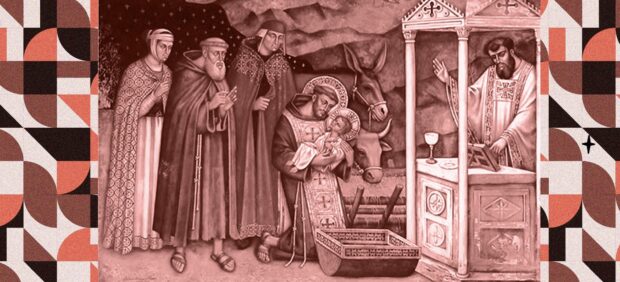MANILA, Philippines—Should you visit a Franciscan church, pray before a Belen and obtain plenary indulgence, or the remission of temporal punishment for sin.
This, as the Order of Franciscan Minors (OFM) said that on the occasion of the 800th anniversary of the “Nativity scene of Greccio,” the Apostolic Penitentiary accepted its request to grant indulgence to church and Belen visitors from Dec 8, 2023 to Feb 2, 2024.
According to Pope Francis’ catechesis on Dec. 20, “800 years ago, at Christmas in 1223, Saint Francis organized the living Nativity scene of Greccio.”
“How did the crib come about? What was Saint Francis’ intention? He said: ‘I want to depict the Child born in Bethlehem, and in some way see with the eyes of the body the hardships in which He found himself for want of the things necessary for an infant, how he was laid in a manger and how He lay on the straw between the ox and the donkey,” the Pope said.
RELATED STORY: Best gift for our family, loved ones
As explained by OFM, “by stopping in prayer in front of the Nativity scenes,” the faithful may obtain the plenary indulgence under usual conditions—Sacramental Confession, Eucharistic Communion, and prayer for the intentions of the Pope.”
OFM’s request for the grant of plenary indulgence was sent to Pope Francis on April 17“in order to promote the spiritual renewal of the faithful and increase the life of grace.”
First ‘Belen’
According to a Franciscan document on the celebration of the eighth centenary of the “Nativity scene of Greccio,” the practice of erecting mangers was started by Saint Francis “as a means to set forth the message of Christmas.”
“When we look upon these figures, the Christmas Gospel comes alive and we are moved to rejoice in the mystery of the incarnation of the Son of God,” it stated.
Greccio is a village in Italy, where Saint Francis staged the world’s first-ever Belen in a cave in 1223. As BBC News said, each year, over 100,000 pilgrims visit the medieval settlement.
It was explained that “as part of his own pilgrimage of faith, Saint Francis had visited Bethlehem in historical Palestine – the Holy Land – in the years 1219-1220.”
BBC News said that “on his return to Greccio, wanting to bring people closer to their faith through the memory of Christ’s birth, he decided to recreate the atmosphere of Jesus’ birth scene in the year’s Christmas celebrations.”
Years later, in 1291, Nicholas IV, the first Franciscan pope, commissioned images to create the first Nativity scene at the Basilica of St. Mary Major in Rome.
Franciscans in PH
To obtain plenary indulgence, a person has to pray before a Belen in a Franciscan church, oratory, or chapel, “spending an appropriate span of time in pious meditation,” especially by reciting Our Father and Profession of Faith.
A Belen is a depiction of the scene of the birth of Jesus in a manger in Bethlehem.
OFM’s Franciscan Communications on Facebook has already posted over 22 Belens in its parishes, friaries, and chapels all over the Philippines that people can visit, including the one at the Basilica Minore de San Pedro Bautista in Quezon City.
Here’s a list of OFM churches in Luzon, based on the website ofmphil.com:
- Santuario de San Antonio Parish, Makati City
- Basilica Minore de San Pedro Bautista, Quezon City
- National Shrine of Our Lady of the Abandones, Manila
- St. Anthony Shrine, Manila
- St. Clare of Asisi Parish, Malabon
- San Jose ang Tagapagtanggol Parish, Quezon City
- St. Anthony of Padua Parish, Cagayan
- Sts. Peter and Paul Parish, Sta. Ana, Cagayan
- St. Mary of the Angels Parish, Sta. Teresita, Cagayan
- Black Nazarene Quasi-Parish, Castañeda, Nueva Vizcaya
- St. Clare of Asisi Parish, Sto. Tomas, Isabela
- St. Francis of Asisi Parish, Santiago City, Isabela
- St. James the Apostle Parish, Dinapigue, Isabela
- St. Mary Magdalene Parish, Palanan, Isabela
- St. Francis of Asisi Shrine, Donsol, Sorsogon
- St. Pope Pius X Parish, San Andres, Catanduanes
There are Belens, too, in churches entrusted to Franciscan Capuchins, OFM Conventuals, and monasteries of St. Clare. These can be visited by Catholics, a priest of the OFM told INQUIRER.net.
As explained by Pope Francis, “the Nativity scene was created to bring us back to what matters: to God who comes to dwell among us.”
“This is why it is important to look at the Nativity scene, because it helps us understand what matters and also the social relationships of Jesus at that time, the family, Joseph and Mary, and loved ones, the shepherds. People before things. And we often put things ahead of people. This doesn’t work,” he said.
